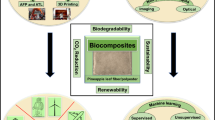Abstract
A reverse engineering technique is proposed in this study for modelling composite sculptured surfaces. The proposed technique includes a surface fitting algorithm and a surface blending algorithm. The former is formulated as the least-squares minimisation problem for which an error expression was minimised which yields the optimised position of control points and parameter values for the non-uniform rational B-spline patch. Cubic spline and bicubic surface algorithms are developed for two-patch and four-patch blending, respectively. Computer simulation results clearly demonstrate that the proposed technique is useful for composite surfaces modelling applications. Factors affecting the convergence speed and surface accuracy in the optimisation process are also discussed.
Similar content being viewed by others
References
B. Bidanda and Y. A. Hosni, “Reverse engineering and its relevance to industrial engineering: a critical review”,Computers Industrial Engineering,26(2), pp. 343–348, 1994.
Y. Takagi, Y. Kojima, M. Yoshida and H. Awane, “A laser-applied three-dimensional profile measuring system”,Hitachi Review 35(1), pp. 25–28, 1986.
Y. A. Hosni and L. Ferreira, “Laser based system for reverse engineering”,Computers Industrial Engineering 26(2), pp. 387–394, 1994.
C. Bradley and G. W. Vickers, “Free-form surface reconstruction for machine vision rapid prototyping”,Optical Engineering 32(9), pp. 2191–2200, 1993.
C. Bradley, G. W. Vickers and M. Milroy, “Reverse engineering of quadratic surfaces employing three-dimensional laser scanning”,Proceedings of the Institution of Mechanical Engineers,208, pp. 21–28, 1994.
C. Jones, C. Bradley and G. W. Vickers, “Laser scanning and quasi-helical tool path definition of arbitrary curved surface models”,Computers Industrial Engineering,26(2), pp. 349–357, 1994.
Y. D. Chen, X. J. Tang and S. M. Wu, “Automatic digitization of free-from curve by coordinate measuring machines”,Symposium of Engineering Surfaces, ASME Winter Annual Meeting, 1992.
H. T. Yau and C. H. Menq, “Reverse engineering in the design of engine intake and exhaust ports”,ASME Winter Meeting, New Orleans, LA, November 1993.
S. Motavalli and B. Bidanda, “Modular software development for digitizing systems data analysis in reverse engineering applications: case of concentric rotational parts”,Computers Industrial Engineering,26(2), pp. 395–410, 1994.
H. P. Bao, P. Soundar and T. Yang, “Integrated approach to design and manufacture of shoe lasts for orthopaedic use”,Computers and Industrial Engineering 26(2), pp. 411–421, 1994.
R. J. Abella, J. M. Daschbach and R. J. McNichols, “Reverse engineering industrial applications”,Computers and Industrial Engineering 26(2), pp. 381–385, 1994.
M. J. Pratt, “Smooth approximation for plane cubic splines”,Computer Aided Geometric Design,2, pp. 165–171, 1985.
J. Hoschek, “Spline approximation of offset curves”,Computer Aided Geometric Design 5, pp. 33–40, 1988.
D. F. Rogers and N. G. Fig, “Constrained B-spline curve and surface fitting”,Computer-Aided Design 21, pp. 641–648, 1989.
B. Sarkar and C. H. Menq, “Parameter optimization in approximation curves and surfaces to measurement data”,Computer Aided Geometric Design 8, pp. 267–290, 1991.
B. Sarkar and C. H. Menq, “Smooth-surface approximation and reverse engineering”,Computer-Aided Design 23(9), pp. 623–628, 1991.
P. N. Chivate and A. G. Jablokow, “Solid-model generation from measured point data”,Computer-Aided Design 25(9), pp. 587–600, 1993.
D. F. Rogers and J.A. Adams,Mathematical Elements for Computer Graphics, McGraw-Hill, 1990.
G. V. Reklaitis, A. Ravindran and K. M. Ragsdell,Engineering Optimization Methods and Applications, John Wiley and Sons, 1984.
Author information
Authors and Affiliations
Rights and permissions
About this article
Cite this article
Lai, JY., Lu, CY. Reverse engineering of composite sculptured surfaces. Int J Adv Manuf Technol 12, 180–189 (1996). https://doi.org/10.1007/BF01351197
Issue Date:
DOI: https://doi.org/10.1007/BF01351197




